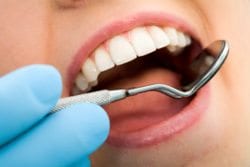Your teeth help you chew. They shape your mouth and, consequently, your entire face. They help you smile, which is how you make first impressions on other people. Yet many of us don’t know which tooth is a bicuspid and which is an incisor.
When we have a toothache and are asked by your Levesque Dentistry dentist, ‘which tooth is bothering you?’, many of us simply point and say, “that one!” like we’re picking out a suspect in a police lineup. So let’s take a moment to get to know our teeth a little better.



Meet Your Teeth
We humans grow two sets of teeth in our lifetime: our primary teeth and our secondary teeth. Our primary teeth are more commonly called our “baby teeth” because they begin growing in when we are only about six months old and are usually all in place by the time we reach three years of age.
Our secondary teeth, also known as our “adult teeth”, begin emerging as our primary teeth begin to fall out. This usually begins by the age of six and finishes up by age twelve.
The average adult person usually has 32 secondary teeth but they are not all the same. Your teeth have different jobs based on their shapes and where they are located in your mouth. You could choose to view them like the players on your favorite football team: each has plays their own position but they work as a team to score points.
The Types of Teeth
- Incisors: These are the eight teeth in the very front of your mouth, primarily used for biting off pieces of food. We have four incisors on the bottom and four on top.
- Canines: These teeth are named after the fangs of a dog- a canine- due to their sharp, pointed appearance. We have four canines in our mouths, two on top and two on the bottom, one on either side of our incisors. Canine teeth are used to rip and tear food.
- Bicuspids: These teeth, sometimes called premolars, are used for chewing and grinding foods. There are four bicuspids in our mouth, two on the top and two on the bottom, one on either side of your canines.
- Molars: Your flat-topped molars, also used for chewing and grinding, grow at rear of your mouth, four on top and four on the bottom, two on each side. Molars are located in ans area that commonly experiences tooth decay due the fact that it is more difficult to clean thoroughly. Many people also have third molars, more commonly referred to as “wisdom teeth” because of when they usually grow in (late teens – early twenties). Four third molars will erupt, one each side, top and bottom. Wisdom teeth that don’t grow in properly due to tooth crowding are said to be “impacted” and usually require a surgical procedure to remove them. Wisdom teeth are also prone to tooth decay due to their location at the very rear of the mouth.
Now that you know you teeth a little better, you will be better able to communicate with Dr. Keith Levesque, Dr. Adrian Levesque or Dr. Tara Vogel when you may be having a problem. For example, if you have pain in the rear of your mouth when you chew your food, you may have an issue with one of molars or wisdom teeth.
At the very least, maybe you now better appreciate the roles your teeth play in chewing your food. It’s commonly believed in sports coaching that a good team is only as strong as its’ weakest player. That’s why it’s important to schedule regular cleanings and exams with Levesque Dentistry in Nashua NH. To schedule call (603) 547-9203 or request an appointment online.
